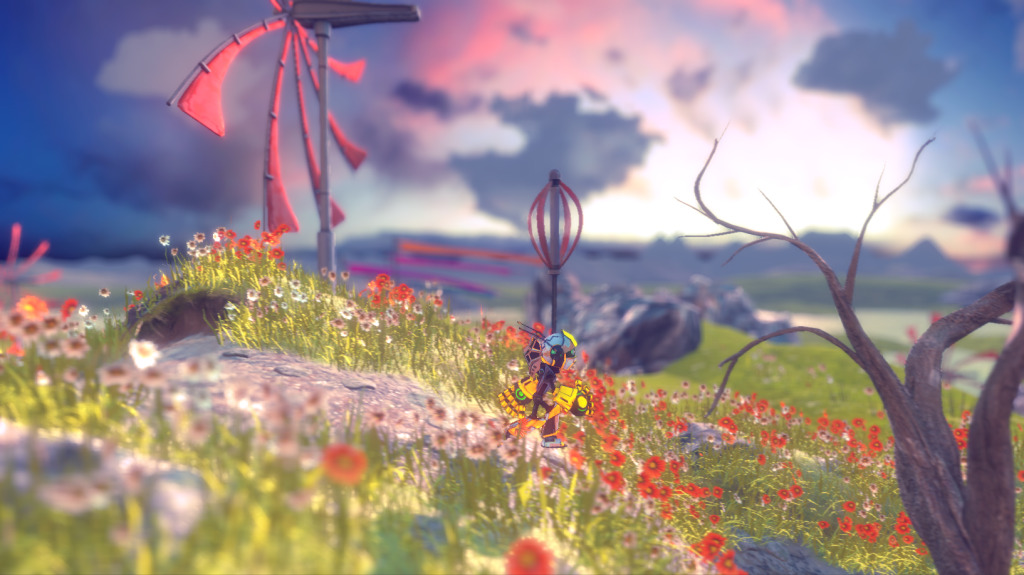andrew@TWLC
Andrew joined
We make stuff, like awesome coffee. Oh, and games. We make games.
I am proud to say that our first Asset pack is now available through the asset store! I feel like a parent gently nudging their kid, still a little unstable on a bike, down a mountain. I’m sure fun will be had and knees shall be scraped. Anyhow, without further ado, please let me present:
![[IMG]](https://media.moddb.com/images/articles/1/169/168966/auto/starterKits.png)
Asset Store Link --> Here! <--
The SSK has the assets you need to get up and running with pretty much any space game idea you could have!
In addition to the spaceships (one, obviously, a paragon for all that is good, the other, well, let us just say could have been hugged a little more), we have included a number of background assets, effects and examples to help get you on your way.
![[IMG]](https://media.moddb.com/images/articles/1/169/168966/auto/shot_01.png)
The Spaceships:
- Triangle counts: ~12,000 / ~6,500 / ~3000 (for High, Mid and Low versions).
- Texture resolutions: 2048k maps (work with both the Unity Standard Shaders as well as our included physical ones).
- Rigs: Both ship sets are rigged allowing for movement of flaps, rotation of wings, engine adjustments, etc.
![[IMG]](https://media.moddb.com/images/articles/1/169/168966/auto/shot_04.png)
![[IMG]](https://media.moddb.com/images/articles/1/169/168966/auto/shot_05.png)
Extras:
- Skybox
- Asteroids
- Various effects (dust clouds, tracers, hit models, etc.)
- 4 Example scenes (the screen shots are straight out of these scenes in Unity Free!)
![[IMG]](https://media.moddb.com/images/articles/1/169/168966/auto/shot_03.png)
We are planning on updating the kit over time, so we would love to hear what you would like to see in it. Also if you are using the Spaceship Starter Kit, got questions or just need advice on coffee machines, please feel free to get in contact with us, we would love to hear from you!
email : themblokes@thatwonderfullemon.co
website : Thatwonderfullemon.co
twitter : Twitter.com
facebook : Facebook.com
The shaders included with this asset are based off of the Physical Shader found at: Wiki.unity3d.com
The adapted shaders are also available for free download at:
Thatwonderfullemon.co ----------We are using the SSK for one of our upcoming projects - more info coming up shortly :)
Good to see you! Welcome to more Super Massive Awesome Robot. This week we shall be taking a look at the thought process that went into our prototype character.
At the beginning of the project we had a rough idea of the goals we wanted to achieve with the game. These goals included things like ‘fast, skill based platformer’, ‘robots’ and ‘awesome’. With these in mind, we formed up a long list of basic world assumptions, things like:
- Initial world unit sizes
- Character height in world units
- Jump heights
- etc.
These assumptions were dependent on whatever the main character (MC) ended up being and doing, but this gave us a starting point.
As the list of assumptions grew, it became obvious that getting a feel for the character was central for the direction of the project. So to start, we began playing with character ideas. We knew it would be a robot of some kind, so we began to play with basic shapes. Below is the initial rough prototype.
 Basic primitives let us experiment without getting too attached or precious
Basic primitives let us experiment without getting too attached or precious
You can see here that our first take was about 3 to 4 ‘heads’ tall. This came from taking inspiration from a lot of classic 8 and 16 bit type games. By contrast, an average adult human is between 6 to 7 heads tall. By reducing ‘head height’ you generally end up with proportions that are close to that of a child, or you push through to more of a stylised look (e.g. Micky Mouse is 3 heads tall; Captain America is 8-9 heads tall; the Hulk is often 14 heads tall).
Traditionally platformers have had small on-screen characters to allow for any action to be framed correctly. Thus proportions and silhouette of the prototype MC are incredibly important. This leads directly into how readable the character is on screen even during hectic action. A good character should be instantly recognisable by silhouette alone.
 Have a bonus donut for naming them all, go on, you are worth it!
Have a bonus donut for naming them all, go on, you are worth it!
Animation (and by extension how a character holds themselves) goes a long way to improving the readability of a silhouette, but the stronger the base shape is, the further the animation can push things.
There are some great examples of silhouette, readability and character development in the classics ‘How to Draw Comics the Marvel Way’ and ‘The Animators Survival Kit’.
You can see that we have emphasised the prototype MC’s hands. Personally, I consider the hands to be the most expressive part of a human, more so than even the eyes, so expanding on this trait to build character was important. Additionally this helps keep the hands readable even through the character is quite small on screen (which proved to be most unexpectedly helpful!).
Using this basic prototype model, we rigged and animated a pass of the basic animations (things like walks, runs, jumps, etc). This allowed us to quickly begin dropping the character into a simple game environment and begin to experiment with controls and movement. In total about one day was spend on the initial prototype model, including the first pass of animations.
The reason for quickly iterating through the character is that we want to give the world of SMAR a whole lot of personality. We could have prototyped game movement with a simple primitive, however having animation and movement considered early helps keep the idea of building personality at the forefront of decisions.
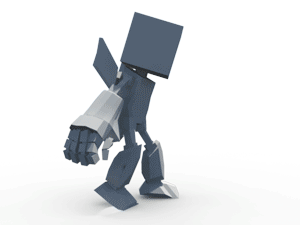
Additional iterations were carried out over a week or so. Some elements were kept, others thrown away. A bit of a side note, we generally approach prototypes as incredibly disposable experiments – you learn, you move on. It allows you to become attached to what is actually good, and not just become precious of the first idea (something we have seen way too much of in game development).
The final prototype iteration of the MC kept a number of bits we liked from the original and we changed others. For instance, in the final version we added a focus on the hands, adding elements that would allow the MC to use them for dashing, jumping and shooting. We also added a number of elements to allow for secondary animation (scarf, antenna, etc).
We will look at animation at another point, but the antenna and scarf were added for the simulation of secondary animation. Animation will move the character, but the simulations will help each moment feel unique and less like a ‘canned’ motion, which in turn adds more life to the MC.
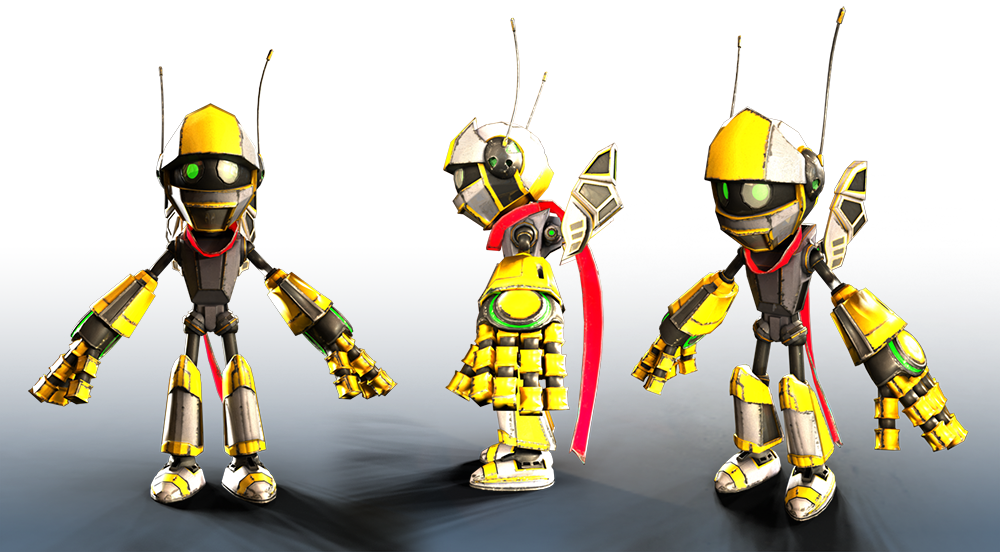 The proto-bot doesn’t have a name. Maybe Tim? These images are quick and dirty renders from the DCC.
The proto-bot doesn’t have a name. Maybe Tim? These images are quick and dirty renders from the DCC.
One of the areas we are playing around with is multiplayer – allowing players to face off against each other seemed like too good an opportunity to miss out on! With this in mind we chose to give the MC bold areas of colour. These areas can be swapped out with minimal fuss (allowing for players to have different colour schemes, helping clarify the action in multiplayer matches).
After a few iterations of rigs with the original prototype, we had a rig we quite liked. A rig usually consists of a skeleton and controls that hold the animation data. Having a standardised rig across the project allowed us to easily drop the test animations onto the final MC model.
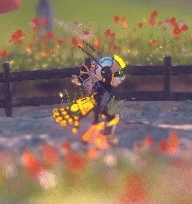
Question, comments, queries, thoughts, musings? Drop us a line and I’ll do my best to work any answers into an upcoming ramble! Next up we shall take a look at movement.
Manly – hugs!
A.
Oh hi!
Pleasure to make your acquaintance! Welcome to the first in a series of rambling, bumbling, dev-blog type posts about Independent Games Development, by an Indie Game Developer.
I’m Andrew, and I work at That Wonderful Lemon Co. where we make games. TWLC is a brand new company with a whole raft of experience behind it. Over the next couple of years we are aiming to grow into something a little bit special and want to drag you along for the journey. After all, it is always more fun when you bring people along for the ride.
First, a short history of us (totally self-indulgent, I know, but bear with me) – Initially TWLC was formed up as a sort of hobby project. A side line to the day job, to allow us to experiment with ideas and concepts without worrying too much about, well, anything! A couple of months ago we released our first game, Lines, onto iPhone / iPad, Facebook and Windows Phone. It was a good experiment and something totally outside of our comfort zone. You can grab a copy now, it’s free.
The freedom was more than a little intoxicating and before I knew it, the day job was left behind and I had thrown myself into the madness that is indie development with both enormous hobbit like feet.
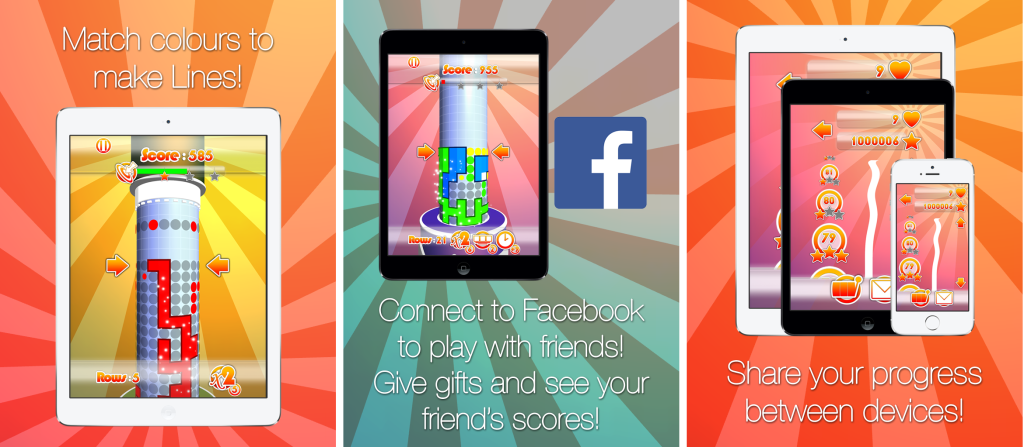 Lines – won an award at Microsoft’s Beautiful Game event
Lines – won an award at Microsoft’s Beautiful Game event
Which brings us to Super Massive Awesome Robot (or SMAR to keep the word count down), our first ‘proper’ project and to start with, the focus of these posts. Over the coming weeks / months / years I aim to bring you an insight into how games are put together, how start-ups grow and to answer any of your burning questions about, well, anything!
Super Massive Awesome Robot
The SMAR project is designed to be a bit of a calling card. Initially we are running the project as a Vertical Slice (literally a slice of the game). In this case and usually across any project, it is built to demonstrate:
- All areas of gameplay
- Initial art style (while exploring the technical limitations of a platform)
- Our technical proficiency
- Feasibility (of both the ideas and the project)
In this case we are aiming the Vertical Slice to be of a quality level somewhere between Alpha (feature complete) and Beta (bug free). It will be a nice demo which we can take to trade shows, conventions, publisher’s door steps, etc, as well as being a strong complement to our design documentation.
To be honest, creating a Vertical Slice is usually a pain in the arse. A publisher often requires a segment of the game to be at (or near) final standard, after only 1/3 of the development time – which causes all sorts of headaches as you can imagine. Creating it first as a proof of concept seemed like the most sensible option for us as a start-up.
‘So, that’s nice and all, but what is SMAR?’ You may ask (or you may not, but now you have read it, I think that’s close enough). Well I’m glad you asked, SMAR is the journey of one small robot to unceremoniously murder its creator. Fun!
Over the years we have been heavily influenced by the likes of Demons Souls, God Hand and Ikaruga. As such, SMAR will be a game where player skill is the focus of gameplay. Our aim is to provide really tight platforming controls, where split-second decisions are rewarded. It is going to be a tricky balance to get right, but that is the sort of thing that gets us up in the morning.
We are also going to be exploring multiplayer with SMAR. We have had a couple of trials already and it is the best kind of bottled madness we could have hoped for. It will be interesting to see how the rules created for the world hold up when the player count goes up.
So, what now?
Over the coming weeks I will aim to break down the SMAR Vertical Slice as we build it, discussing areas such as the character, controls, movement, frame rate choices, production choices, audio design etc. We may also from time to time dip into other projects we have on the go.
In addition to this blog, I will be throwing together short videos to illustrate / show off what has been in chatted here. Hopefully this will provide you with a unique take on how a game is built in addition to soothing you with my sultry tones. Fire over any questions and I’ll work the answers into the next video or ramble. Here’s this weeks one (please watch it in HD!):
Till next time, Manly-hugs!
A.
